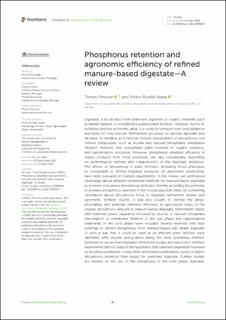| dc.contributor.author | Persson, Tomas | |
| dc.contributor.author | Rueda-Ayala, Victor | |
| dc.date.accessioned | 2022-11-18T15:01:41Z | |
| dc.date.available | 2022-11-18T15:01:41Z | |
| dc.date.created | 2022-11-03T14:53:11Z | |
| dc.date.issued | 2022-10-11 | |
| dc.identifier.citation | Frontiers in Sustainable Food Systems. 2022, 6 1-19. | en_US |
| dc.identifier.issn | 2571-581X | |
| dc.identifier.uri | https://hdl.handle.net/11250/3032933 | |
| dc.description.abstract | Digestate, a by-product from anaerobic digestion of organic materials such as animal manure, is considered a suitable plant fertilizer. However, due to its bulkiness and low economic value, it is costly to transport over long distances and store for long periods. Refinement processes to valorize digestate and facilitate its handling as a fertilizer include precipitation of phosphorus-rich mineral compounds, such as struvite and calcium phosphates, membrane filtration methods that concentrate plant nutrients in organic products, and carbonization processes. However, phosphorus retention efficiency in output products from these processes can vary considerably depending on technological settings and characteristics of the digestate feedstock. The effects of phosphorus in plant fertilizers (including those analogous or comparable to refined digestate products) on agronomic productivity have been evaluated in multiple experiments. In this review, we synthesized knowledge about different refinement methods for manure-based digestate as a means to produce phosphorus fertilizers, thereby providing the potential to increase phosphorus retention in the food production chain, by combining information about phosphorus flows in digestate refinement studies and agronomic fertilizer studies. It was also sought to identify the range, uncertainty, and potential retention efficiency by agricultural crops of the original phosphorus amount in manure-based digestate. Refinement chains with solid/wet phase separation followed by struvite or calcium phosphate precipitation or membrane filtration of the wet phase and carbonization treatments of the solid phase were included. Several methods with high potential to extract phosphorus from manure-based wet phase digestate in such a way that it could be used as an efficient plant fertilizer were identified, with struvite precipitation being the most promising method. Synthesis of results from digestate refinement studies and agronomic fertilizer experiments did not support the hypothesis that solid/wet separation followed by struvite precipitation, or any other refinement combination, results in higher phosphorus retention than found for unrefined digestate. Further studies are needed on the use of the phosphorus in the solid phase digestate, primarily on phosphorus-rich soils representative of animal-dense regions, to increase understanding of the role of digestate refinement (particularly struvite precipitation) in phosphorus recycling in agricultural systems. | en_US |
| dc.language.iso | eng | en_US |
| dc.publisher | Frontiers Media S.A. | en_US |
| dc.rights | Navngivelse 4.0 Internasjonal | * |
| dc.rights.uri | http://creativecommons.org/licenses/by/4.0/deed.no | * |
| dc.title | Phosphorus retention and agronomic efficiency of refined manure-based digestate—A review | en_US |
| dc.title.alternative | Phosphorus retention and agronomic efficiency of refined manure-based digestate—A review | en_US |
| dc.type | Peer reviewed | en_US |
| dc.type | Journal article | en_US |
| dc.description.version | publishedVersion | en_US |
| dc.rights.holder | © 2022 Persson and Rueda-Ayala. | en_US |
| dc.source.pagenumber | 1-19 | en_US |
| dc.source.volume | 6 | en_US |
| dc.source.journal | Frontiers in Sustainable Food Systems | en_US |
| dc.identifier.doi | 10.3389/fsufs.2022.993043 | |
| dc.identifier.cristin | 2068738 | |
| dc.relation.project | Norges forskningsråd: 294625 | en_US |
| dc.source.articlenumber | 993043 | en_US |
| cristin.ispublished | true | |
| cristin.fulltext | original | |
| cristin.qualitycode | 1 | |

